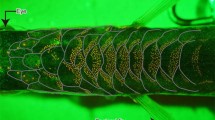Abstract
Branching patterns of the trunk lateral line nerves were studied in 46 pleuronectiform species, representing nine families in two suborders. The dorsal fin longitudinal ramus (DFLR), derived from the main nerve (horizontal septum lateral line nerve), passed closely along the course of the middle trunk lateral line in all specimens examined, the dorsal longitudinal collector nerve (DLCN) partly coalescing with the DFLR along the arched part of the lateral line in Psettodes erumei (Psettodoidei), compared with the entire length of the latter in all other species (Pleuronectoidei). Citharidae, Paralichthyidae, and Pleuronectidae were characterized by having a simple, elongated dorsal ramule; Bothidae was unique in having more than one dorsal ramule, forming a ladder-like network and peripherally giving off numerous minute branches; Poecilopsettidae and Samaridae possessed a few, short dorsal ramules; Soleidae and Cynoglossidae were characteristic in having a dendritic dorsal ramule. Secondary modifications of the course of the middle trunk lateral line were detected by nerve information, the arched part of the lateral line having been secondarily highly elevated in some genera of Pleuronectidae, but secondarily straightened in Samaridae.









Similar content being viewed by others
References
Amaoka K (1969) Studies on the sinistral flounders in the waters around Japan: taxonomy, anatomy and phylogeny. J Shimonoseki Univ Fish 18:65–340
Azevedo MFC, Oliveira C, Pardo BG, Marinez P, Foresti F (2008) Phylogenetic analysis of the order Pleuronectiformes (Teleostei) based on sequences of 12S and 16S mitochondrial genes. Genet Mol Biol 31(1) suppl:284–292
Berendzen PB, Dimmick WW (2002) Phylogenetic relationships of Pleuronectiformes based on molecular evidence. Copeia 2002:642–652
Chanet B (2003) Interrelationships of scophthalmid fishes (Pleuronectiformes: Scophthalmidae). Cybium 27:275–286
Chanet B, Desoutter M, Guintard C (2007) Imagerie médicale et plastination au service de la compréhension de la phylogénie des poisons plats (Pleuronectiformes). Cybium 31:117–123
Chapleau F (1993) Pleuronectiform relationships: a cladistic reassessment. Bull Mar Sci 52:516–540
Cole FJ, Johnston J (1901) Liverpool marine biological committee memoirs, no. 8. Pleuronectes (the plaice). Trans Liverpool Biol Soc 16:145–396, pls 1–11
Coombs S, Janssen J, Webb JF (1988) Diversity of lateral line systems: evolutionary and functional considerations. In: Atema J, Fay RR, Popper AN, Tovolga WN (eds) Sensory biology of aquatic animals. Springer, New York, pp 553–593
Cooper JA, Chapleau F (1998) Phylogenetic status of Paralichthodes algoensis (Pleuronectiformes: Paralichthodidae). Copeia 1998:477–481
Filipski GT, Wilson MVH (1984) Sudan Black B as a nerve stain for whole cleared fishes. Copeia 1984:204–208
Fraser TH, Freihofer WC (1971) Trypsin modification for Sihler technique of staining nerves for systematic studies of fishes. Copeia 1971:574–576
Freihofer WC (1972) Trunk lateral line nerves, hyoid arch gill rakers, and olfactory bulb location in atheriniform, mugilid, and percoid fishes. Occas Pap Calif Acad Sci 95:1–31
Friedman M (2008) The evolutionary origin of flatfish asymmetry. Nature 454:209–212
Hoshino K (2001a) Homologies of the caudal fin rays of Pleuronectiformes (Teleostei). Ichthyol Res 48:231–246
Hoshino K (2001b) Monophyly of the Citharidae (Pleuronectoidei: Pleuronectiformes: Teleostei) with considerations of pleuronectoid phylogeny. Ichthyol Res 48:391–404
Munroe TA (2005) Systematic diversity of the Pleuronectiformes. In: Gibson RN (ed) Flatfishes: biology and exploitation. Blackwell, Oxford, pp 10–41
Nakae M, Sasaki K (2008) Branchial arch muscle innervation by the glossopharyngeal (IX) and vagal (X) nerves in Tetraodontiformes, with special reference to muscle homologies. J Morph 269:674–690
Nakae M, Sasaki K (2009) Lateral line system and its innervation in Tetraodontiformes with outgroup comparisons: descriptions and phylogenetic implications. J Morph. doi:10.1002/jmor.10817
Nelson JS (2006) Fishes of the world, 4th edn. Wiley, New York
Northcutt RG, Holmes PH, Albert JS (2000) Distribution and innervation of lateral line organs in the channel catfish. J Comp Neurol 421:570–592
Ochiai A (1966) Studies on the comparative morphology and ecology of the Japanese soles. Misaki Mar Biol Inst Kyoto Univ Spec Rep (3):1–97, pls 1–2
Sakamoto K (1985) Interrelationships of the family Pleuronectidae (Pisces: Pleuronectiformes). Mem Fac Fish Hokkaido Univ 31:95–215
Sasaki K, Takiuye K, Nakae M (2007) Homologies of cephalic lateral line canals in Pseudorhombus pentophthalmus and Engyprosopon grandisquama (Pleuronectiformes): innervation and upper eye floor formation. Ichthyol Res 54:186–192
Yamanaka Y, Nakae M, Fukuda E, Sasaki K (2009) Monophyletic origin of the dorsally arched lateral line in Teleostei: evidence from nerve innervation patterns. Ichthyol Res. doi:10.1007/s10228-009-0122-1
Acknowledgments
H. Motomura (Kagoshima University Museum) and the staff of Borneo Marine Research Institute, Universiti Malaysia Sabah, were extremely helpful during the first author’s Psettodes research trip. H. Imamura (Hokkaido University) donated a number of Hokkaido pleuronectid specimens. G. Hardy (Ngunguru, New Zealand) read the manuscript and offered helpful comments.
Author information
Authors and Affiliations
Corresponding author
About this article
Cite this article
Fukuda, E., Nakae, M., Asaoka, R. et al. Branching patterns of trunk lateral line nerves in Pleuronectiformes: uniformity and diversity. Ichthyol Res 57, 148–160 (2010). https://doi.org/10.1007/s10228-009-0141-y
Received:
Revised:
Accepted:
Published:
Issue Date:
DOI: https://doi.org/10.1007/s10228-009-0141-y




